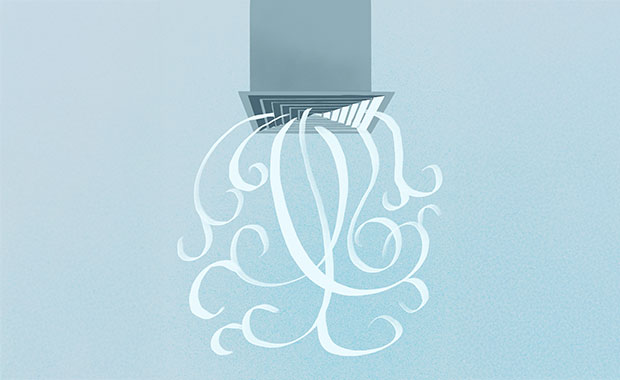Air handling units (AHUs) are a critical component of any healthcare facility’s HVAC system, conditioning, filtering, and distributing air to various hospital areas.
In 2020, the State University of New York (SUNY) Downstate Health Sciences University (DHSU), formerly known as SUNY Downstate Medical Center, faced concerns about five of the hospital’s rooftop-mounted AHUs at the longstanding public medical school and hospital in Brooklyn, N.Y.
Specifically, the New York hospital’s units were more than 20 years old and used the now phased-out R-22 refrigerant, also known as HCFC-22 or Freon, which is no longer manufactured because it’s an ozone-depleting substance.
This article explores how the project team determined the best approach forward.
Planning AHU upgrades in an existing hospital
With oversight from the State University Construction Fund (SUCF), a New York State public-benefit corporation, the hospital hired RMF Engineering Inc. (Baltimore) to conduct multiple field surveys over six months to document existing conditions of the AHUs.
This included recording airflow readings, which are measured in cubic feet per minute (CFM), and pressure readings to determine baseline performance for each air system. Flow readings were also noted to determine heating, water, and steam needs to supply each AHU.
Once complete, RMF developed a feasibility report that provided upgrade and replacement options and recommendations based on its findings. The report outlined maintenance impacts, energy efficiency optimization, construction phasing options, and construction cost estimates.
Next, the project team reviewed each option to consider various factors, such as code assessment, upgrade options to the energy management and electrical systems, ventilation air calculations using energy modeling software, full heating and cooling load calculations, filtration options, and existing ductwork.
Through this process, the key elements that emerged were the need for a reliable central system with spare capacity to allow for future flexibility.
After thorough evaluation, DHSU and SUCF decided to replace three units—the labor and delivery, neonatal intensive care unit (NICU), and prostate imaging recurrence reporting and magnetic resonance imaging (PIRR/MRI) care units—due to the critical areas they each serve, the ongoing maintenance issues associated with these units, and overall condition. The remaining two AHUs were designated to be addressed by a later project.
Planning AHU systems for future capacity needs
Joining RMF Engineering Inc. on the $10 million system modernization were structural engineer Siracuse Engineers PC (Buffalo, N.Y.), hazardous materials engineer Encorus Group (Buffalo), and architect Azar Design Co (Buffalo).
As part of the project, DHSU requested that the new AHUs be sized to accommodate more outside air than required by code. This decision was in response to the fact that certain spaces in the hospital require differing quantities of outside air, as well as SUNY’s desire to have flexibility in the future if space functions are relocated or altered within the building.
In response, RMF designed each system with a custom air handling unit with extra coil capacity for cooling and heating to properly condition the additional quantity of outside air. Additionally, the associated reheat system components, which include the steam to power hot water heat exchangers, circulation pumps, and associated valving, were replaced.
Since COVID, many facility owners and clients are striving for enhanced safety precautions to improve indoor air quality and minimize the risk of spreading airborne viruses, bacteria, and particulates.
As part of the SUNY project, the new AHUs were also equipped with ultraviolet light, which destroys or inactivates microorganisms such as bacteria and viruses, to improve indoor air quality. Additionally, the new units featured standard minimum efficiency reporting value (MERV) 14 filters required for these applications.
To support the new equipment, the project team also extended the existing electrical and building automation systems to the new AHUs after installation, bringing them into the hospital’s energy profile for the future.
Ensuring uninterrupted operations during AHU installation
A key challenge of the project was the need to maintain uninterrupted 24/7 operations at the existing hospital throughout construction. Of the departments receiving upgraded AHUs, the NICU and labor and delivery units were at the highest risk due to the sensitive and urgent needs of their patient populations.
To ensure these departments didn’t experience any significant disruptions beyond several hours or an overnight shutdown, RMF worked closely with SUCF and DHSU to plan construction staging in coordination with hospital operations for a seamless transition.
The project was completed over a two-year duration, with each of the AHU replacements representing one of three major milestones to achieve. The project timeline was set up in a linear fashion by swapping each unit out at different times with the main goal to ensure the affected areas didn’t experience disruptions in supply air.
To minimize the cost impacts of renting temporary equipment, the design team designated one of the new AHUs to act as the temporary unit while the existing ones were being replaced.
The labor and delivery department AHU was identified as the most logical selection for this task because of its central location between the three new AHUs and its capacity being the largest of the three units.
Phased installation of AHUs
The utility connections including steam and reheat water systems were reviewed in detail to ensure the connections could support both the existing labor and delivery unit and the new unit while it served as the temporary AHU.
This resulted in the installation of the new labor and delivery unit adjacent to the existing unit, with ductwork extended to serve the NICU and PIRR/MRI systems while those units were replaced in their existing locations. The AHU servicing the NICU already had supply and return ductwork distribution above the roof, allowing for quick connections to the system.
Team coordination was important to develop details that did not penetrate the roof membrane to provide proper support for the temporary ductwork and limit impact to the roof during construction.
Following the installation of the AHU for the PIRR/MRI area, the final project stage included removal of the existing labor and delivery unit and final connections to the new unit, which had been functioning as the temporary unit.
Equipment removals/installations and temporary system connections took place early in the morning on Saturdays, which are the least busy days for the hospital. The connection process to the temporary systems and ultimately final system connection was quick and completed within the day.
In case of emergency, the project team had outlined a back-up plan to transfer patients across the street to Kings County Hospital Center if any complications arose and the units experienced a disruption in service, however, the emergency plan wasn’t utilized.
Increasing building airflow with updated air handling system
The enhanced capacity of the new AHUs increased the building’s airflow, or CFM, by 10 percent.
Specifically, the new unit serving the labor and delivery department delivers 13,000 CFM of supply air, the NICU unit distributes 12,000 CFM, and the PIRR/MRI units produce 9,500 CFM—providing more load than necessary for the current systems to support future renovations, new equipment, and evolving patient care requirements. This allows for the hospital to add more space or take on new equipment in the future.
Overall, proper investigation of the hospital’s immediate needs was key to determining the top priorities for the project, including understanding any potential future requirements, to ensure the design is equipped with the appropriate flexibility to meet changing demands.
Developing clear and defined documents was also crucial. Together, these steps helped outline a clear achievable path to success.
Rich Heim, PE, LEED AP, is a project manager at RMF Engineering (Baltimore) and can be reached at [email protected].
Illustration by David Senior













